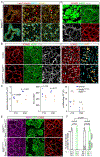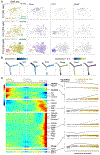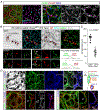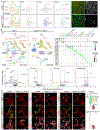Epithelial Vegfa Specifies a Distinct Endothelial Population in the Mouse Lung
- PMID: 32059772
- PMCID: PMC7170573
- DOI: 10.1016/j.devcel.2020.01.009
Epithelial Vegfa Specifies a Distinct Endothelial Population in the Mouse Lung
Abstract
The lung microvasculature is essential for gas exchange and commonly considered homogeneous. We show that VEGFA from the epithelium is required for a distinct endothelial cell (EC) population in the mouse lung. Vegfa is predominantly expressed by alveolar type 1 (AT1) cells and locally required to specify a subset of ECs. Single-cell RNA sequencing (scRNA-seq) reveals that ∼15% of lung ECs are transcriptionally distinct-marked by Carbonic anhydrase 4 (Car4)-and arise from bulk ECs, as suggested by trajectory analysis. Car4 ECs have extensive cellular projections and are separated from AT1 cells by a limited basement membrane without intervening pericytes. Car4 ECs are specifically lost upon epithelial Vegfa deletion; without Car4 ECs, the alveolar space is aberrantly enlarged despite the normal appearance of myofibroblasts. Lung Car4 ECs and retina tip ECs have common and distinct features. These findings support a signaling role of AT1 cells and shed light on alveologenesis.
Keywords: CAR4; VEGF; alveologenesis; angiogenesis; endothelial cell; lung alveolar type 1 cell; lung development; lung vasculature; single-cell RNA-seq; vascular biology.
Copyright © 2020 Elsevier Inc. All rights reserved.
Conflict of interest statement
Declaration of Interests The authors declare no competing interests.
Figures







Comment in
-
VEGF Drives the Car toward Better Gas Exchange.Dev Cell. 2020 Mar 9;52(5):546-547. doi: 10.1016/j.devcel.2020.02.009. Dev Cell. 2020. PMID: 32155436 Free PMC article.
References
-
- Abman SH (2001). Bronchopulmonary dysplasia: “a vascular hypothesis”. Am J Respir Crit Care Med 164, 1755–1756. - PubMed
-
- Aird WC (2007a). Phenotypic heterogeneity of the endothelium: I. Structure, function, and mechanisms. Circ Res 100, 158–173. - PubMed
-
- Aird WC (2007b). Phenotypic heterogeneity of the endothelium: II. Representative vascular beds. Circ Res 100, 174–190. - PubMed
Publication types
MeSH terms
Substances
Grants and funding
LinkOut - more resources
Full Text Sources
Other Literature Sources
Molecular Biology Databases
Research Materials

